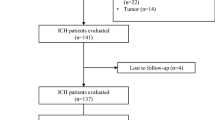Abstract
Introduction
Severity of illness scores predict all-cause mortality after intracerebral hemorrhage (ICH), but do not differentiate between proximate mechanisms or predict the timing. We hypothesized that death by neurologic criteria [brain death (BD)], withdrawal of life support, and cardiovascular death would be distinct after ICH.
Methods
We prospectively enrolled patients with spontaneous ICH without underlying vascular malformation or neoplasm. We recorded clinical data and the proximate mechanism of death (BD, withdrawal of life support, cardiovascular death, or other cause). Time to death was compared with Kaplan–Meier methods (log-rank test). Data are median (IQR).
Results
Among 89 patients, 15 had withdrawal of life support, 5 had BD, 2 died from cardiac arrest, and 3 died from other causes. Among patients who died, ICH score, age, Glasgow Coma Scale, NIH Stroke Scale, and proximate cause were not associated with the proximate mechanism of death. The time to death was different (P < 0.001) depending on the proximate mechanism. Patients with BD died 1 [0–1] 1 day after ICH, withdrawal of life support led to death 5 [1–13] days after ICH, cardiac death occurred 35 [35–85] days after ICH, and other causes led to death 33 [26–33] days after ICH. Among patients where life support was withdrawn, a higher ICH score on admission was related to earlier death (P = 0.002).
Conclusions
Proximate mechanisms of death after ICH occur at distinct times. Withdrawal of life support leads to earlier death in patients with a higher severity of injury. Medical causes of death can be effectively prevented after ICH.

Similar content being viewed by others
References
Becker K, Baxter A, Cohen W, Bybee H, Tirschwell D, Newell D, et al. Withdrawal of support in intracerebral hemorrhage may lead to self-fulfilling prophecies. Neurology. 2001;56:766–72.
Quality Standards Subcommittee of the American Academy of Neurology. Practice parameters for determining brain death in adults. Neurology. 1995;45:1012–4.
Hays A, Diringer MN. Elevated troponin levels are associated with higher mortality following intracerebral hemorrhage. Neurology. 2006;66:1330–4. doi:10.1212/01.wnl.0000210523.22944.9b.
Diringer MN, Edwards D, Aiyagari V, Hollingsworth H. Factors associated with withdrawal of mechanical ventilation in a neurology/neurosurgery intensive care unit. Crit Care Med. 2001;29:1792–7. doi:10.1097/00003246-200109000-00023.
Mayer SA, Kossoff SB. Withdrawal of life support in the neurological intensive care unit. Neurology. 1999;52:1602–9.
Helft P, Siegler M, Lantos J. The rise and fall of the futility movement. N Engl J Med. 2000;343:293–6. doi:10.1056/NEJM200007273430411.
Teasdale G, Jennett B. Assessment of coma and impaired consciousness. A practical scale. Lancet. 1974;2:81–4. doi:10.1016/S0140-6736(74)91639-0.
Brott T, Adams H, CP O, Marler J, WG B, Biller J, et al. Measurements of acute cerebral infarction: A clinical examination scale. Stroke. 1989;20:864–70.
Claude Hemphill J, Bonovich DC, Besmertis L, Manley GT, Johnston SC, Tuhrim S. The ICH score: A simple reliable grading scale intracerebral hemorrhage. Stroke. 2001;32:891–7.
Kothari RU, Brott T, Broderick JP, Barsan WG, Sauerbeck LR, M Z, et al. The ABCs of measuring intracerebral hemorrhage volumes. Stroke. 1996;27:1304–5.
Anderson C, Huang Y, Wang J, Arima H, Neal B, Peng B, et al. Intensive blood pressure reduction in acute cerebral haemorrhage trial (INTERACT): A randomised pilot trial. Lancet Neurol. 2008;7:391–9. doi:10.1016/S1474-4422(08)70069-3.
Marotta CA, Banks JL. Outcomes validity and reliability of the modified rankin scale: implications for stroke clinical trials: A literature review and synthesis. Stroke. 2007;38:1091–6. doi:10.1161/01.STR.0000258355.23810.c6.
Hemphill JC, Newman J, Zhao S, Johnston SC. Hospital usage of early do-not-resuscitate orders and outcome after intracerebral hemorrhage. Stroke. 2004;35:1130–4. doi:10.1161/01.STR.0000125858.71051.ca.
Diringer MN, Edwards D. Admission to a neurologic/neurosurgical intensive care unit is associated with reduced mortality rate after intracerebral hemorrhage. Crit Care Med. 2001;29:635–40. doi:10.1097/00003246-200103000-00031.
Varelas PN, Conti MM, Spanaki MV, Potts E, Bradford D, Sunstrom C, et al. The impact of a neurointensivist-led team on a semiclosed neurosciences intensive care unit. Crit Care Med. 2004;32:2191–8.
Bernat JL. Areas of consensus in withdrawing life-sustaining treatment in the neurointensive care unit. Neurology. 1999;52:1538.
White DB, Curtis JR, Lo B, John M, Luce M. Decisions to limit life-sustaining treatment for critically ill patients who lack both decision-making capacity and surrogate decision-makers. Crit Care Med. 2006;34:2053–9. doi:10.1097/01.CCM.0000227654.38708.C1.
Boissy AR, Ford PJ, Edgell RC, Furlan AJ. Ethics consultations in stroke and neurological disease: A 7-year retrospective review. Neurocrit Care. 2008;9(3):394–9.
Rost NS, Smith EE, Chang Y, Snider RW, Chanderraj R, Schwab K, et al. Prediction of functional outcome in patients with primary intracerebral hemorrhage. The FUNC score. Stroke. 2008;39(8):2304–9.
Flemming K, Wijdicks E, Li H. Can we predict poor outcome at presentation in patients with lobar hemorrhage? Cerebrovasc Dis. 2001;11:183–9. doi:10.1159/000047636.
Weimar C, Benemann J, Diener HC, German Stroke Study Collaboration. Development and validation of the Essen Intracerebral Haemorrhage Score. J Neurol Neurosurg Psychiatry. 2006;77:601–5. doi:10.1136/jnnp.2005.081117.
Tuhrim S, Dambrosia JM, Price TR, Mohr JP, Wolf PA, Hier DB, et al. Intracerebral hemorrhage: External validation and extension of a model for prediction of 30-day survival. Ann Neurol. 1991;29:658–63. doi:10.1002/ana.410290614.
Broderick JP, Brott TG, Duldner JE, Tomsick T, Huster G. Volume of intracerebral hemorrhage. A powerful and easy-to-use predictor of 30-day mortality. Stroke. 1993;24:987–93.
Acknowledgments
Andrew M. Naidech has received research support from NovoNordisk and the Northwestern Memorial Foundation unrelated to this work, and speaker fees from EKR Therapeutics (unrelated to this work).
Author information
Authors and Affiliations
Corresponding author
Additional information
All persons who significantly contributed to the manuscript are listed as the author.
Rights and permissions
About this article
Cite this article
Naidech, A.M., Bernstein, R.A., Bassin, S.L. et al. How Patients Die After Intracerebral Hemorrhage. Neurocrit Care 11, 45–49 (2009). https://doi.org/10.1007/s12028-009-9186-z
Received:
Accepted:
Published:
Issue Date:
DOI: https://doi.org/10.1007/s12028-009-9186-z




